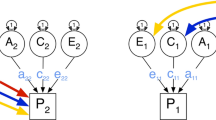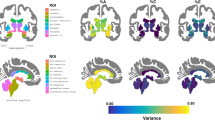Abstract
Historically, the focus of behavior genetic research was to obtain estimates of the sources of familial resemblance for a single phenotype. Current research strategies have moved beyond heritability estimates to the search for physiological and behavioral mechanisms by which genetic risk is translated into individual differences in behavior and disease liability. Such research questions often require multivariate designs and complex analytic models, including the analysis of continuous and categorical dependent variables within the same model. Recent advances in computer software for categorical data analysis have increased the tools available for researchers in behavior genetics. This paper describes how to use the Mplus software program (Muthén and Muthén, 1998, 2002) for the analysis of data obtained from twins. Example analyses include two- and five-group twin models for univariate and bivariate continuous and categorical variables. Data on alcoholism and age at first drink drawn from the Virginia Adult Twin Study of Psychiatric and Substance Use Disorders are used to illustrate how Mplus can be used to analyze multiple-category variables, recode and transform variables, select subgroups for analysis, handle subjects with incomplete data, include constraints to ensure non-negative loadings, include model covariates, model sex differences, and test alternative hypotheses about mediation of genetic risk by measured variables.
Similar content being viewed by others
References
American Psychiatric Association. (1994). Diagnostic and Statistical Manual of Mental Disorders (4th ed.). Washington, DC: American Psychiatric Association.
Arbuckle, P., and Wothke, W. (1999). AMOS User's Guide, version 4. Chicago, IL: SPSS.
Behrman, J. R., Taubman, P., and Wales, T. J. (1978). The roles of genetics and environment in the distribution of earnings. In Griliches, Z., Krelle, W., Krupp, H.-J., and Kyn, O. (eds.), Income Distribution and Economic Inequality (pp. 220-239). New York: J. Wiley and Sons.
Bentler, P. M. (1989). EQS: Structural Equations Program Manual. Los Angeles, CA: BMDP Statistical Software.
Boomsma, D. I., and Molenaar, P. C. (1986). Using LISREL to analyze genetic and environmental covariance structure. Behav. Genet. 16:237-250.
Cantor, R. M., and Nance, W. E. (1981). An application of confirmatory factor analysis to individual finger ridge count data from the offspring of MZ twins. Am. J. Hum. Genet. 33:134A.
Cantor, R. M. (1983). A multivariate analysis of ridge count data from the offspring of monozygotic twins. Acta Genet. Med. Gemellol 32:161-207.
Cattell, R. B. (1960). The multiple abstract variance analysis equations and solutions: For nature-nurture research on continuous variables. Psych. Rev. 67:353-377.
Eaves, L. J., Last, K. A., Young, P. A., and Martin, N. G. (1978). Model fitting approaches to the analysis of human behavior. Heredity 41:249-320.
Edwards, J. H. (1969). Familial predisposition in man. Br. Med. Bull. 25:58-64.
Falconer, D. S. (1965). The inheritance of liability to certain diseases, estimated from the incidence among relatives. Ann. Hum. Genet. 29:51-76.
Fulker, D. W. (1973). A biometrical genetic approach to intelligence and schizophrenia. Soc. Biol. 20:266-275.
Fulker, D. W. (1978). Multivariate extensions of a biometrical model of twin data. Prog. Clin. Biol. Res. 24A:217-236.
Guo, G., and Wang, J. (2002). The mixed or multilevel model for behavior genetic analysis. Behav. Genet. 32:37-49.
Hannah, M. C., Hopper, J. L., and Mathews, J. D. (1983). Twin concordance for a binary trait. I. Statistical models illustrated with data on drinking status. Acta Genet. Med. Gemellol 32:127-137.
Jinks, J. L., and Fulker, D. W. (1970). A comparison of the biometrical genetical, MAVA and classical approaches to the analysis of human behaviour. Psychol. Bull. 73:311-349.
Joreskog, K. G. (1973). Analysis of covariance structures. In Krishnarah, P. R. (ed.), Multivariate Analysis III: Proceedings of the Third International Symposium on Multivariate Analysis. New York: Academic Press.
Joreskog, K. G., and Sorbom, D. (1977). LISREL: Analysis of Linear Structural Relationships by the Method of Maximum Likelihood. Chicago, IL: National Educational Resources.
Joreskog, K. G., and Sorbom, D. (1986). PRELIS: A Preprocessor for LISREL. Mooresville, IN: Scientific Software.
Kaprio, J., Sarna, S., and Koskenvuo, M. (1981). Multivariate logit analysis of concordance ratios for qualitative traits in twin studies. Acta Genet. Med. Gemellol. 30:267-274.
Kendler, K. S., and Prescott, C. A. (1999). A population-based twin study of lifetime major depression in men and women. Arch. Gen. Psychiatry 56:39-44.
Martin, N. G., and Eaves, L. J. (1977). The genetical analysis of covariance structure. Heredity 38:79-95.
Mather, K., and Jinks, J. L. (1971). Biometrical Genetics (2nd ed.). London: Chapman and Hall.
McArdle, J. J., Connell, J. P., and Goldsmith, H. H. (1980). Structural modeling of stability and genetic influences: Some results from a longitudinal study of behavioral style. Behav. Genet. 10:487.
McArdle, J. J., and Goldsmith, H. H. (1990). Alternative common factor models for multivariate biometric analyses. Behav. Genet. 20:569-608.
McArdle, J. J., and McDonald, R. P. (1984). Some algebraic properties of the reticular action model. Br. J. Math. Stat. Psych. 37:234-251.
McArdle, J. J., and Prescott, C. A. (1996). Contemporary models for the biometric genetic analysis of intellectual abilities. In Flanagan, D. P., Genshaft, J. L., and Harrison P. L. (eds.), Intellectual Assessment: Contemporary and Emerging Theories, Tests and Issues (pp. 403-436). New York: Guilford Press.
Meyer, J. M., Eaves, L. J., Heath, A. C., and Martin, N. G. (1991). Estimating genetic influences on the age-at-menarche: A survival analysis approach. Am. J. Med. Genet. 39:148-154.
Muthén, B. O. (1988). LISCOMP: Analysis of Linear Structural Equations Using a Comprehensive Measurement Model (2nd ed.). Mooresville, IN: Scientific Software.
Muthén, B., and Asparouhov, T. (2002). Latent variable analysis with categorical outcomes: Multiple-group and growth modeling in Mplus, version 5, December 9, 2002. www.statmodel.com/mplus/examples/webnote.html
Muthén, B., Shedden, K., and Spisic, D. (1999). General Latent Variable Mixture Modeling. Tech. Report. Santa Monica, CA: Muthén and Muthén.
Muthén, L. K., and Muthén, B. O. (1998). Mplus User's Guide. Los Angeles, CA: Muthén and Muthén.
Muthén, L. K., and Muthén, B. O. (2002). Mplus VERSION 2.12: Addendum to the Mplus user's Guide. Los Angeles, CA: Muthén and Muthén.
Neale, M. C. (1991). Mx: Statistical Modeling, Department of Human Genetics. Richmond, VA: Virginia Commonwealth University.
Neale, M. C., and Cardon, L. R. (1992). Methodology for Genetic studies of Twins and Families. Dordrecht: Kluwer Academic Publishers.
Neale, M. C., Boker, S. M., Xie, G., and Maes, H. H. (2002). Mx: Statistical Modeling (5th ed.). Richmond, VA: Department of Psychiatry, Virginia Commonwealth University.
Prescott, C. A. (1991). Clinical, Psychometric and Biometric Assessment of Schizophrenia: A Psychiatric Twin Study. University of Virginia. Unpublished Dissertation.
Prescott, C. A., Aggen, S. H., and Kendler, K. S. (1999). Sex differences in the sources of genetic liability to alcohol abuse and dependence in a population based sample of U.S. twins. Alcohol Clin. Exp. Res. 23:1136-1144.
Prescott, C. A., Cross, R. J., Kuhn, J. W., Horn, J. L., and Kendler, K. S. (in press). Is risk for alcoholism mediated by individual differences in drinking motivations? Alcohol Clin. Exp. Res.Author: Please supply missing information.
Prescott, C. A., and Gottesman, I. I. (1990). Biometric prediction of genetic liability for schizophrenia. Behav. Genet. 20:742.
Prescott, C. A., and Kendler, K. S. (1999a). Age at first drink and risk for alcoholism: A noncausal association. Alcohol Clin. Exp. Res. 23:101-107.
Prescott, C. A., and Kendler, K. S. (1999b). Genetic and environmental contributions to alcohol abuse and dependence in a populationbased sample of male twins. Am. J. Psychiatry 156:34-40.
Prescott, C. A., and Kendler, K. S. (2001). Associations between marital status and alcohol consumption in a longitudinal study of female twins. J. Stud. Alcohol 62:589-604.
SAS Institute. (1999). SAS/STAT Software, version 8. Cary NC: SAS Institute.
Smith, C. (1974). Concordance in twins: Methods and interpretation. Am. J. Hum. Genet. 6:454-466.
Waller, N. G., and Muthén, B. O. (1992). Genetic Tobit factor analysis: Quantitative genetic modeling with censored data. Behav. Genet. 22:265-292.
Yashin, A. I., Iachine, I. A., and Harris, J. R. (1999). Half of the variation in susceptibility to mortality is genetic: Findings from Swedish twin survival data. Behav. Genet. 29:11-19.
Author information
Authors and Affiliations
Rights and permissions
About this article
Cite this article
Prescott, C.A. Using the Mplus Computer Program to Estimate Models for Continuous and Categorical Data from Twins. Behav Genet 34, 17–40 (2004). https://doi.org/10.1023/B:BEGE.0000009474.97649.2f
Issue Date:
DOI: https://doi.org/10.1023/B:BEGE.0000009474.97649.2f




